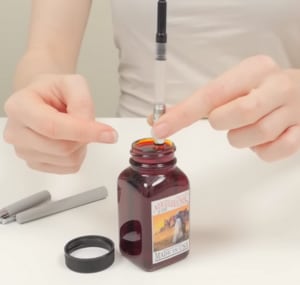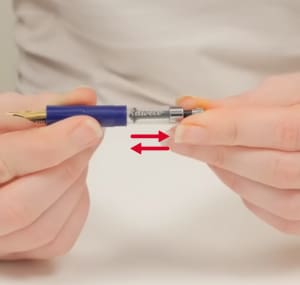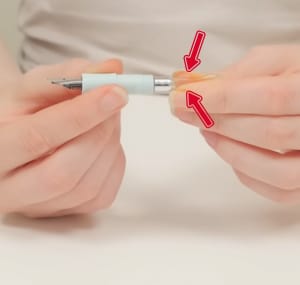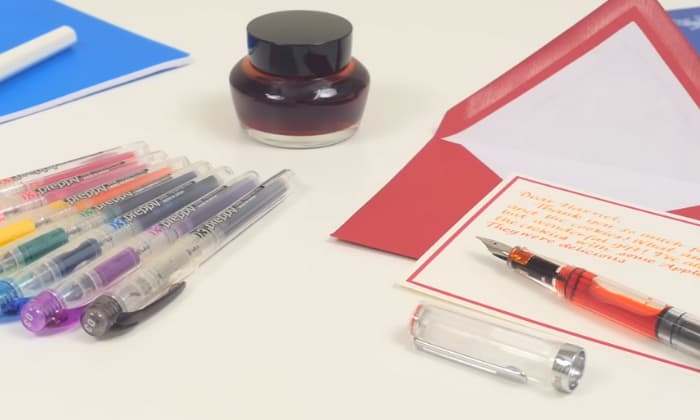Delving into the world of fountain pens introduces you to an array of impressive skills, including using a fountain pen converter.
How to use a fountain pen converter? First, insert the converter into the pen, submerge the nib in the ink bottle, and twist the converter to draw up the ink. You can see that the process is pretty simple.
In an era where digital communication dominates, fountain pens’ timeless charm and elegance continue to allure many. This article will show you everything from choosing the right converter to the precise refilling procedure.
Keep reading to learn how to fill a fountain pen with a converter!
Table of Contents
What is a Fountain Pen Converter?
A fountain pen converter is a refillable device that lets you refill fountain pens by drawing ink in the bottled ink through the nib instead of ink cartridges.
It essentially works as a reservoir, using a simple mechanism, usually a screw or a squeeze operation, to draw ink into the pen for use.
Fountain Pen Converter Instructions
What to prepare
- A fountain pen
- A bottle of fountain pen ink
- A fountain pen converter
- Towel paper
Steps to fill a fountain pen converter
There are several fountain pen converter types such as the Piston Converter, Squeeze Converter, and Push-Button Converter.
Each type of cartridge converter, while uniquely designed, generally operates on similar principles. This is because most of them feature a twist knob that maneuvers a piston within the converter to generate suction that pulls ink from a bottle into the pen.
Now, let’s delve into the specifics to understand the mechanics of each!
- Step 1: Insert the fountain pen piston converter into the fountain pen in its place. Ensure it is securely fitted.
- Step 2: Place the nib of your pen fully into the ink bottle to avoid drawing in the air instead of ink.
Most pens have a breather hole at the base of the nib to draw ink. Therefore, the pen can’t draw ink successfully if the entire nib isn’t dipped.
The next steps differ depending on the types of converter you have:
For piston converter
- Step 3: Twist the knob on the piston converter counterclockwise to move the piston down. This will create a vacuum.
Now, slowly twist the knob clockwise. This will draw the ink into the converter through the nib and feed of the pen.
- Step 4: Check to see if the converter is full. If it’s not, repeat step 3 until the converter is sufficiently filled.
- Step 5: Once fully raised, remove the pen from the ink bottle. Use a cloth or paper towel to gently wipe off any excess ink from the nib and the pen’s body.
- Step 6: The last step is to reassemble the pen.
Remember to cap your pen when it’s not in use to prevent the ink from drying out.
For Plunger Converters
- Step 3: Instead of twisting the knob, you pull and push the plunger up and down to move the piston.
Keep repeating steps 4, 5, and 6.
For Squeeze Converter
- Step 3: Refill the ink by pressing and releasing the sac firmly and repeatedly.
Each time you release the pressure, a vacuum is created which draws ink up into the converter. You also can see air bubbles escaping from the pen.
- Step 4: Take a moment to examine the amount of ink drawn into the converter.
Don’t try to fill 100%, you’ll observe that it’s likely only about half to two-thirds full.
This is not an issue, rather it’s quite typical. Squeeze converters, due to their design and function, generally draw and hold a lesser volume of ink compared to other types of converters.
You should know that the ink capacity is different between types of filling mechanisms. But most fountain pens can hold 0.7 and 2.5ml of ink.
Now repeat the steps 5 and 6 like the other converter’s instructions.
For Push-Button Converter
This is the least common ink converter fountain pen.
- Step 3: Press the button on the converter to expel any air. Release the button quickly and steadily to create a vacuum that draws ink into the converter. You may need to repeat this process a few times to fill the converter sufficiently.
Finally, you carry on the steps 4, 5, and 6 above.
Frequently Asked Questions
Troubleshooting Tips When Using Fountain Pen Converter
- Ink Not Drawing Up: If you’re having trouble drawing ink into your converter, ensure the entire nib of the pen is submerged in the ink. The pen draws ink through a breather hole at the base of the nib. If this isn’t entirely submerged, the pen may struggle to draw ink.
- Leakage: If your converter leaks, check to ensure it is securely fitted to the pen. Also, inspect it for any cracks or damage.
- Incompatibility Issues: Some pens require a specific type or brand of converter. In this case, you’ll need to seek out a converter that’s specifically designed to work with your pen model.
Some universal converters, such as the Fountain Pen Screw-Type Converter, are designed to fit in most fountain pens. It may be a good solution for less common converter sizes.
Benefits Of Using A Fountain Pen Converter
Using a fountain pen converter provides several advantages, one of the most appealing being the ability to switch ink colors effortlessly.
A converter allows you to access a myriad of bottled ink options, enabling you to explore a vast palette of hues that aren’t usually available in cartridges.
It not only enriches your writing experience with varied colors but also is more environmentally friendly by reducing cartridge waste.
Care And Maintenance Of Fountain Pen Converters
- Clean your converter regularly to prevent ink from drying and clogging. Rinse it with lukewarm water until the water runs clear.
- Allow the converter to dry thoroughly before refilling it with ink.
- When installing or removing the converter, be gentle to avoid damaging it.
- Regularly inspect your converter for any cracks or signs of wear.
- Store your pen properly to prevent ink from drying out.
Difference Between A Fountain Pen Ink Converter Vs Cartridge
A fountain pen ink converter and a cartridge are two different systems for delivering ink to a fountain pen.
A converter is a refillable mechanism that allows the use of bottled ink, offering more ink color options and reducing waste.
In contrast, a cartridge is a pre-filled, disposable unit that provides convenience and ease of use, ideal for on-the-go situations.
However, when they run out of ink, some people have to refill them with syringe, very inconvenient. Cartridges also limit the range of available ink colors.
Conclusion
That’s the detailed guide on how to use a fountain pen converter. Whether it’s a piston, squeeze, or push-button converter, each type has its unique operation but all serve the same purpose. Remember, the whole nib must be submerged so the pen can draw ink and avoid the fountain pen converter not filling.
With careful use, regular cleaning, and the right troubleshooting, a converter can greatly enrich your fountain pen writing experience.

Art has always been a part of my life; it influences my upbringing and later my career choice. For me, it is always a part of my parenting technique. So for whichever purpose that you come to art, you can start here with us.








